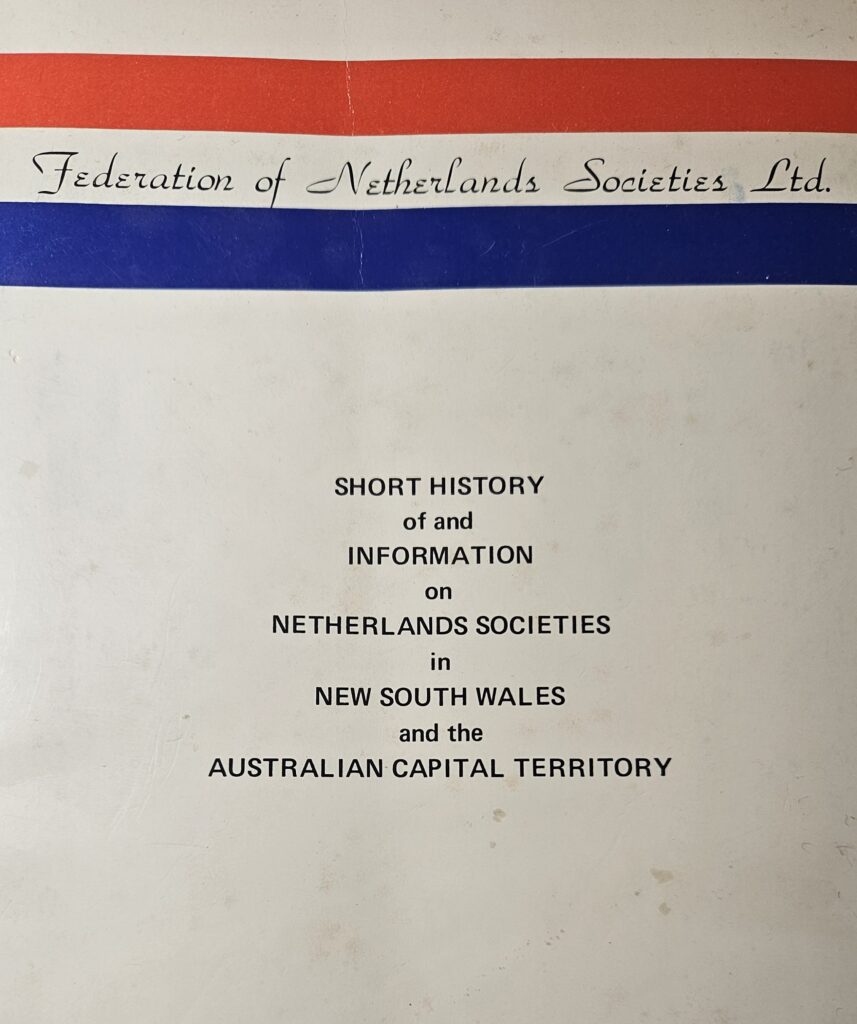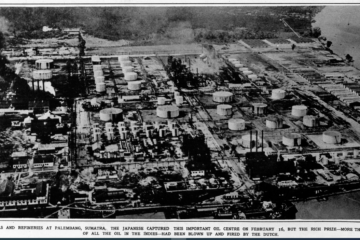
Short history of and information on Netherlands Societies in NSW and the ACT.
The following text is from this booklet published by the Federation of Netherlands Societies Ltd. in February 1985. The research for this booklet was done by Mijntje Hage.
Acknowledgement
Many thanks to the clubs, their secretaries, and the many members of the various societies who have made it possible for me to write this booklet. Without their assistance, it could not have been done. To mention all the people who gave willingly of their spare time would make too long a list. Let it suffice to say that I am very grateful for their time and assistance given.
Mijntje Hage
The Netherlands Society in Sydney De Nederlandse Vereniging in Sydney
The history of this club goes back 40 years. On July 25, 1944, “De Nederlandsche Vereeniging in New South Wales” was founded in the canteen of the Dutch Services Overseas. Its objectives and aims were many. To name a few: enhance community spirit, look after the interests of Dutch subjects, foster cultural interests, and collect money for Australian and Dutch charities. Its immediate goal, however, was to have at least one meeting per month. After all those 40 years, the club has not changed much, except for a greater diversity in members and a name change to “The Netherlands Society in Sydney”, more of which will be discussed later.
At present, the social get-together is on the first Monday of each month. This is combined with either a lecture, film, or discussions about current affairs or other interests. The subjects of the evening vary greatly in order to satisfy as many members as possible. Many of the ‘talks’ are given in the English language for two reasons:
- to enable the non-Dutch speaking partners of members to participate in the activities of the club,
- to attract the ‘second generation’ of Dutch-Australians.
No matter which language is spoken, the atmosphere of the club is very ‘Dutch’. Most Monday evening meetings generally have the same pattern. The room on the 14th floor in the Philips Building, Blue Street, North Sydney, is open from 7.30 p.m., thus enabling members to mix, chat, and have a cup of coffee before the event starts at 8.30 p.m. After the evening’s event, refreshments and snacks are served and most of those present will stay for further small talk, discussions, or conversations.
The members of the Netherlands Society in Sydney live all over the metropolitan area and often are also members of another local Dutch club. Over the years, this Society has always tried to maintain its aims and objectives, for example, in the early years, immediately after the war, the Committee of the “Vereeniging” made submissions to both the Australian and the Dutch authorities for financial assistance for housing, as finance was difficult to obtain. A variety of charitable institutions are supported, both Australian and Dutch. Each year, at the Annual General Meeting, it is decided to which charity a donation will be made. There is also a keen interest in supporting sporting clubs. It was, for instance, with financial assistance from the Netherlands Society that the hockey team, “The Dutch Eleven”, a few years ago, started playing in the competition. Similarly, many years ago, the soccer club Sydney-Austral was supported by society.
As mentioned before, not all that much has changed over the years. The “Oranje-Bal”, held on the Queen’s birthday each year, has, since 1968, been organised by the Federation of Netherlands Societies.
Membership fees are less than they were 40 years ago, and as an illustration of this, 10 shillings then was worth a lot more than $10 is now. (The average income in 1944 was approximately 10 pounds per week.) Until 1953, this club was the only Dutch club in the metropolitan area. Thus, one can imagine that the monthly meetings were well attended, as there weren’t that many opportunities to be ‘Dutch among the Dutch’ and a little ‘gezelligheid’ went down very well indeed. One should not forget the often-lively discussions in the way of politics or religion. (Was that maybe the reason that in the first constitution of the “Vereeniging”, it was virtually forbidden to discuss these topics?)
It was not until after the great influx of immigrants in the early fifties that participation in the club slowly diminished. The reasons were simple: husbands who often went out first to get a ‘start’ in the way of employment and housing, were re-united with their families and moved to the city fringes. Frequently, these families had lived in a migrant hostel for a period and these hostels were situated a fair distance outside the city centre. Transport was in most cases difficult and costly, not to mention the expense of babysitters. It was in those years that the name of the Society underwent a change. Several people, from the Sutherland Shire in the South, Condell Park near Bankstown, and Narrabeen in the North, put a request forward to “De Nederlandse Vereeniging in NSW to change its name to “De Nederlandse Vereniging in Sydney” (The Netherlands Society in Sydney). The reason for this was to open possibilities for Dutchmen in other parts of the metropolitan area to establish a local club that could carry the adjective “Nederlands”. As this seemed a reasonable request, the Society complied and became “The Netherlands Society in Sydney”. This heralded the birth of many Dutch clubs.
Over the years, interest in this society fluctuated, yet the result in 1985 is that of a healthy club with approximately 150 members with a growing interest from the children of the first arrivals, at least from those over 25 years of age.
WWII activities
Prior to moving on to the clubs and societies in the suburbs and the major towns in N.S.W., more information should be available about Dutch activities during and after the war.
Before the foundation of the present Sydney club, an attempt was made to establish a Dutch society in 1938. Very little is known about it. It was short-lived and financially not very sound. During the war, attempts were made to save the club, but to no avail. The financial rescue was undertaken by:
The Netherlands Relief Fund(WWII)
From the scant information available emanates an emergency fund that assisted the Dutch military forces in Australia and probably the Dutch East Indies in the war effort. Even though things were uncertain during the war years, an enormous generosity was present. Apart from money, clothes and blankets were also collected. Christmas parcels were sent out and help was given where necessary to people in distress both in the Netherlands and the former Dutch East Indies. Their balance sheet (see file below) shows that large amounts of money were at times paid out, for instance: to save the teetering Dutch Club until its closure in 1942, a sum of 1695 Pounds 18/6 was donated. This equalled three high annual incomes, compared with 1985. More than 20,000 pounds were distributed amongst the following: the Queen Wilhelmina Benevolent Fund, Princess Margriet Fund, Prince Bernhard Fund, the Netherlands Indies Red Cross, various seamen’s missions, and other charitable organisations. In this case, it is justified to paraphrase the words of Winston Churchill “seldom in history have so few done so much for so many”.
After the war, in January 1946, the Fund was dissolved. Money still on hand and all incoming donations had to go to “
The Social Welfare Committee
The objectives of this committee are:
- Sensitising Government Departments, other organisations and individuals to the real needs of the Dutch community.
- Acting as a forum for the exchange of information, trends and ideas in the Social Welfare field, partly through association and membership of e.g. Council on the Ageing, ACOSS.
- Acting as an advisory body to members of the Federation and others on Welfare matters, programmes and needs in the Dutch community.
- Co-ordinating Welfare work within the Dutch community and acting as a referral Centre for individual cases.
- Prepare for the taking over of the “Aged Programme”, at present administered by the Catholic Dutch Migrant Association Australia (NSW).
- Examine and further define objectives as may be found necessary from time to time.
To be successful, any committee needs a lot of support. This is forthcoming in great measure from the community.
The Netherlands Benevolent Trust Fund
The Netherlands Benevolent Trust Fund was founded in March 1980 under the sponsorship of the Netherlands Emigration Board at The Hague. The objectives of the Trust Fund, which evolved from the activities of the Netherlands Housing Societies in Australia, are to assist migrants of Dutch origin and otherwise further the general welfare of the Dutch community by providing financial benefits to charitable organisations operating for the advancement of the Dutch Community in Australia.
The Trust Fund is managed and controlled by a Board consisting of five trustees, the majority of whom must be persons of Dutch nationality or Dutch origin.
The Trust Fund’s income is derived from interest received on investments in the Netherlands Savings and Investment Society of N.S.W., Netherlands Investment Society in Victoria and the Australian Netherlands Credit Union Limited.
In March each year, the Trustees distribute the interest received over the preceding twelve months to various charitable organisations which conform to the objectives set out in the first paragraph.
Over recent years, the Queen Wilhelmina Benevolent Fund, the Princess Marijke Relief Fund of Queensland, the Juliana Village Association of N.S.W. and other similar charitable organisations have been given financial assistance which is not confined to any particular State. It should be mentioned that special financial assistance was given to victims of the disastrous bush fires in Victoria and South Australia in 1982 through the Dutch Fire Victims Relief Fund.
Meeting places
Although the Sydney club never had enough money to possess its own premises, it had managed to establish a central meeting point in the City. In 1950, certain individuals, together with the club, bought the then-named “Niagara Cafe” in George Street and renamed it “Tulips Restaurant”. This establishment became a great success, due to two factors; firstly, it was the only place in Sydney where the Dutch, with reasonable certainty, could find fellow countrymen, and secondly, it was a place where a woman could go to meet other women or friends, without feeling uncomfortable. Please bear in mind that Australia anno 1950 had a totally different mentality than that of 1985. Of course, there were other places where women could go, but they were too expensive, too exclusive, and completely alien to them in as far as a familiar atmosphere was concerned, not to mention the difficulties or lack of understanding of the English language. After some years, “The Tulips” became independent from the Netherlands Society. It was closed in 1969.
The policy regarding immigration was to promote decentralisation, in other words, to populate this vast country. It should, therefore, be no surprise that most immigrants found their first accommodation away from the big cities. There was the ‘famous’ camp Bonegilla, many miles from Melbourne, and here, in N.S.W., the camps near Bathurst, (the first ‘Holding Centre’ in N.S.W.), Newcastle, and Wollongong. As most people came to Australia to seek a better future for themselves and their children, they were prepared to work hard. Only those camps near places where work was available remained, for instance, Greta near Newcastle and the Illawarra hostel near Wollongong.
From the Dutch people in those migrant hostels sprung the Netherlands Society Concordia (Newcastle & District), and the Dutch Australian Society in Illawarra (D.A.S.I.). The hostel’s Dutch immigrants in Bathurst headed for the Big Smoke as soon as possible, so no club was formed there, although a flourishing Dutch club existed in Orange some 35 years ago.
Developments beyond Sydney
Soon after Wollongong and Newcastle, 3 clubs were almost simultaneously, clubs were founded in the outer areas of Sydney. One must not forget that in those days, Sutherland, Condell Park, and Narrabeen were considered as the ‘most’ outer suburbs. This was also the peak of the so-called “assisted passage immigration scheme”. Literally thousands and thousands of people of all nationalities arrived in Australia, and among them, during the fifties, were about 10,000 Dutch migrants per year. The ones who set foot on land from the Sibajak, Zuiderkruis, Grote Beer, and Johan Van Oldenbarneveldt, to name just a few of the ships, could not possibly all live near the city. Besides, for most of the arrivals, the ‘migrant hostel’ was their first accommodation. As this was situated in not the most pleasant of surroundings and a fair distance away from the city, it was for that reason that certain people, mentioned earlier on, put their request to the Nederlandsche Vereeniging in N.S.W. and it was then that the new clubs were formed. Many people tried to attend the monthly meetings in the city, but in the long run it proved to be too difficult, and without canceling their old membership of the city club, they went their own way. Another vital point in having a club not too far away was to alleviate the loneliness of the women.
After having been at the ‘migrant hostel’, many bought a block of land, built a garage on it, and used that as a temporary dwelling. This offered cramped quarters, and with small children, little money to spend, often a limited knowledge of the English language and living next to neighbors in the same position, but often being of a different nationality, this could, at times, make life very lonely. A meeting now and then, offering some Dutch conversation, dancing, and the gezelligheid meant the difference between living and only just existing. The “Tulips” was often too far away, no matter how much one wished to go.
So it happened that, in August 1953 – the Sutherland Club, in November 1953 – the Bankstown Club, and in March 1954 – Neerlandia were established. They are the oldest Netherlands societies in Sydney except for “The Netherlands Society in Sydney”.
Football
If there was one thing the newly arrived Dutch missed, it was “voetbal” or soccer. It was therefore that Sydney Austral provided for this need. The team was formed in 1948 and all the players were Dutch. It had tremendous support and was one of the first soccer clubs that contributed to the increase in popularity of soccer in Australia after World War II. The financial support faded, and, unfortunately, to the great chagrin of the many followers, the team had to be disbanded in 1969. A number of players went to play for the Western Suburbs.
To remain on the topic of sport, the “Dutch Eleven”, a hockey team, must be mentioned. This team started in 1978, but apparently hockey is not as popular as soccer. The Dutch Eleven can do with a bit of support, which is inverse to the enthusiasm the players put in.
22 The following groups concen,Late mainly on song and dance: the Folkloristic groups, the choirs and the Carnival societies. The oldest is:
See also: History of the Netherlands co-operative terminating building society schemes

